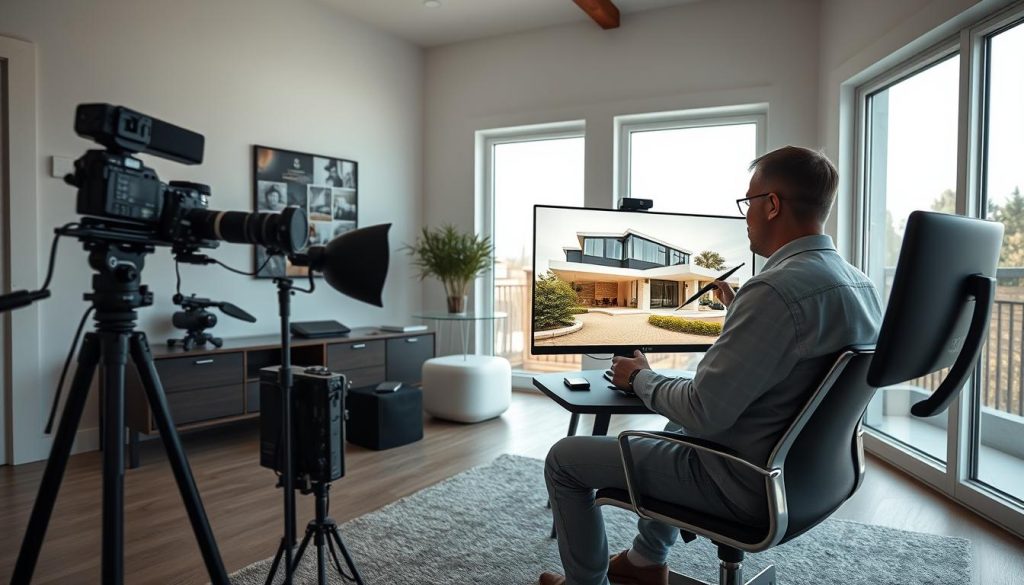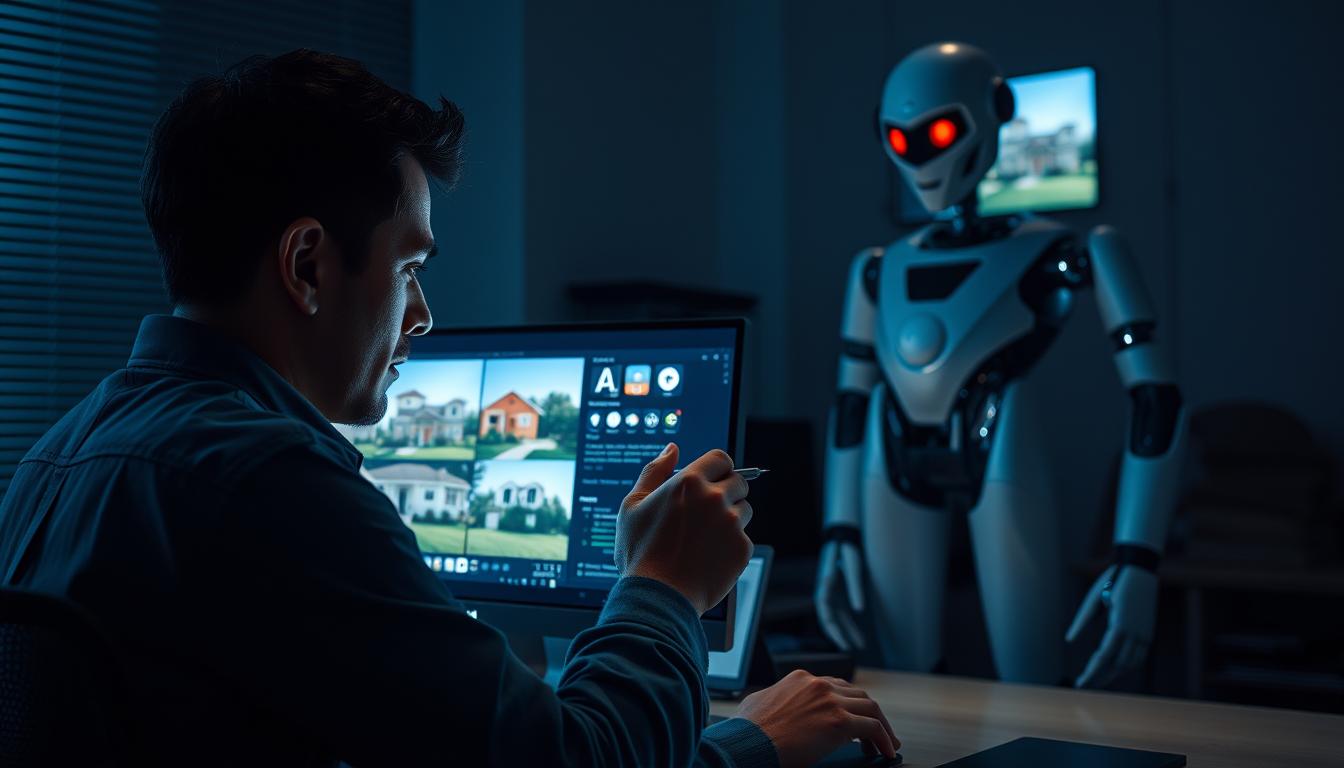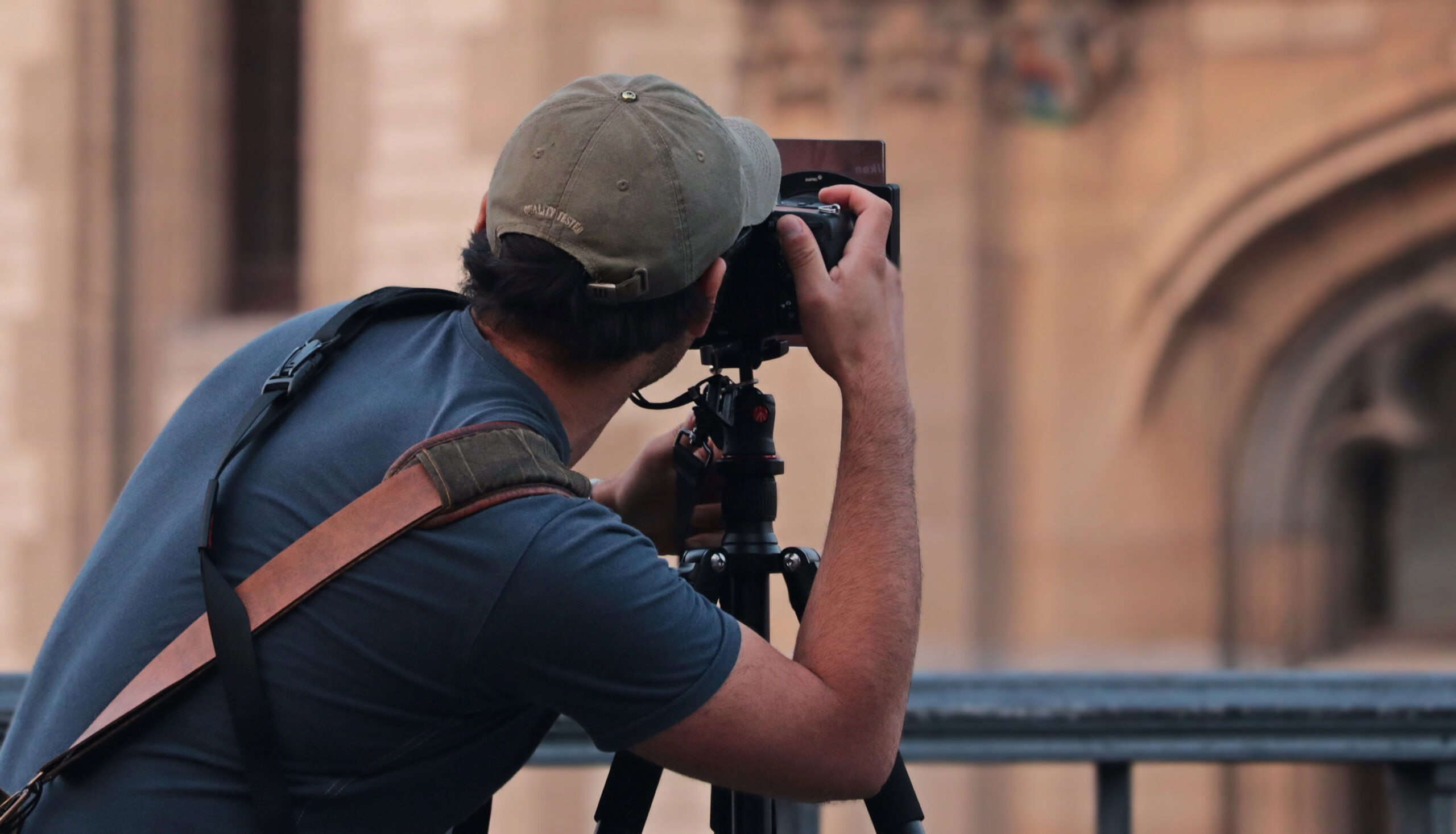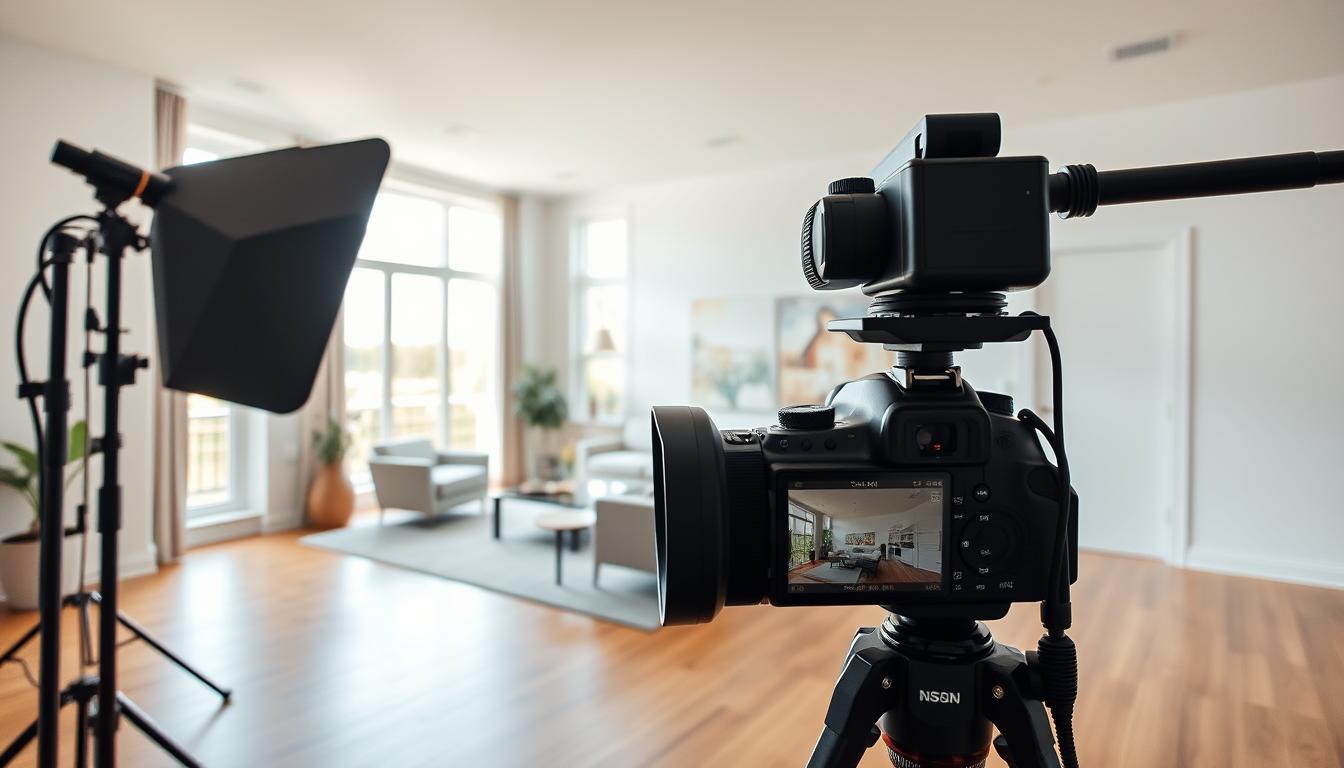In the rapidly evolving world of real estate photography, the debate between human editors and AI-driven solutions is heating up. While AI has made tremendous progress, human editors bring a level of nuance and understanding to property marketing that AI currently can’t match.
Human editors can capture the essence of a property, highlighting its best features and making it more appealing to potential buyers. This personal touch is crucial in a competitive market where the visual presentation can make or break a sale.
From film to digital, the journey of real estate photography reflects broader shifts in the industry. This evolution has not only changed how properties are presented but also how they are perceived by potential buyers.
Impact of Quality Photography on Property Sales
Quality photography plays a crucial role in property marketing. It directly influences buyer engagement and conversion rates. High-quality images can make a property more attractive, leading to increased interest.
Conversion Rate Statistics
| Listing Type | Average Conversion Rate |
|---|---|
| Listings with Professional Photos | 4.5% |
| Listings without Professional Photos | 1.5% |
Buyer Engagement Metrics
Properties with high-quality photos tend to receive more views and engagement. Studies have shown that listings with professional photos can increase buyer engagement by up to 50%.
Understanding AI Real Estate Photo Editing
The integration of AI in real estate photo editing has revolutionized the way properties are presented online. This technological advancement has not only streamlined the editing process but also enhanced the quality of property images, making them more appealing to potential buyers.
Several AI-powered editing platforms have emerged in the real estate market, offering a range of services from basic enhancements to complex editing tasks. Platforms like PhotoDirector and LensFix utilize AI algorithms to automatically adjust brightness, contrast, and saturation, ensuring that property photos look their best.
How AI Algorithms Process Property Images
AI algorithms process property images through sophisticated techniques, including machine learning and automated enhancement processes.
Machine Learning Techniques
Machine learning involves training AI models on vast datasets of images to learn patterns and features that define high-quality property photos. This training enables the AI to make informed decisions when editing new images, such as adjusting exposure or removing unwanted objects.
Automated Enhancement Processes
Automated enhancement processes use pre-programmed rules and AI-driven insights to improve image quality. These processes can include sky replacement, object removal, and color correction, all aimed at presenting the property in the most attractive light.
By leveraging these advanced technologies, AI real estate photo editing services can significantly enhance the visual appeal of properties, making them stand out in a crowded online market.
Capabilities of Modern AI in Property Enhancement
AI’s capabilities in property enhancement are transforming how real estate professionals present properties. Modern AI algorithms can analyze and edit property images with unprecedented precision, offering a range of tools that enhance the visual appeal of listings.
Automated Color Correction and Exposure Adjustment
One of the key features of AI in property enhancement is its ability to automatically correct colors and adjust exposure levels in images. This ensures that property photos look more natural and appealing, making them more attractive to potential buyers.
Sky Replacement and Basic Object Removal
AI-driven sky replacement and basic object removal are other significant capabilities. These features allow for the enhancement of outdoor property images by replacing dull skies with more vibrant ones and removing unwanted objects, thereby improving the overall aesthetic of the property.
Virtual Staging Possibilities
Virtual staging is another powerful tool offered by AI in property enhancement. It enables the digital furnishing of empty properties, helping potential buyers visualize the space more effectively. This not only saves time and resources but also makes the property more appealing in listings.
Limitations of AI in Real Estate Photography
The use of AI in real estate photography has seen a significant rise, yet it encounters several hurdles. While AI algorithms have become increasingly sophisticated, they still face challenges that human editors handle with ease.
Handling Complex Lighting Scenarios
One of the primary limitations of AI in real estate photography is its struggle with complex lighting scenarios. High contrast lighting can often confuse AI algorithms, leading to suboptimal results. For instance, a room with both bright sunlight and deep shadows can be difficult for AI to balance effectively.
Architectural Distortion and Perspective Issues
AI can sometimes struggle with correcting architectural distortions and maintaining the correct perspective in property images. While AI can make adjustments, it may not always understand the nuances required to present a property in its best light.
Inability to Make Context-Aware Aesthetic Judgments
AI lacks the human touch when it comes to making aesthetic judgments that are context-aware. It may not fully understand the specific style or appeal that a particular property or neighborhood demands.
Property-Specific Challenges
Different properties have unique characteristics that AI may not fully capture. For example, a historic home may require editing that preserves its original features, while a modern apartment might need a more contemporary touch.
Neighborhood and Market Context
Understanding the neighborhood and market context is crucial for effective real estate photography. AI may not always grasp the subtleties of what makes a property appealing to potential buyers in a specific area.
| Challenge | AI Limitation | Human Advantage |
|---|---|---|
| Complex Lighting | Struggles with high contrast | Can adjust for optimal balance |
| Architectural Distortion | May not correct fully | Can maintain correct perspective |
| Aesthetic Judgments | Lacks context-aware understanding | Can make nuanced aesthetic decisions |
Human Advantage: Artistic Vision in Property Presentation
Human editors bring a level of creativity and emotional understanding to property presentations that AI systems currently cannot match. This unique ability to infuse artistic vision into real estate photography is what sets human editors apart.
Understanding Emotional Appeal in Real Estate Marketing
The emotional appeal of a property is a crucial factor in real estate marketing. It’s not just about showcasing the physical attributes of a home; it’s about creating an emotional connection with potential buyers. Human editors understand how to enhance images in a way that evokes feelings of warmth, comfort, and luxury, making a property more appealing to buyers.
Elements that contribute to emotional appeal include:
- Warm and inviting lighting
- Beautifully landscaped gardens and outdoor spaces
- Luxurious interior designs and finishes
Creating a Narrative Through Visual Editing
Creating a narrative through visual editing involves more than just enhancing the visuals; it’s about telling the story of the property and its potential to become a home. Human editors achieve this by understanding the target buyer’s psychology and applying property storytelling techniques.
Target Buyer Psychology
Understanding the psychology of the target buyer is essential in creating a narrative that resonates. Human editors consider factors such as age, lifestyle, and preferences to tailor the visual presentation of the property. For instance, a family home might be edited to highlight spacious living areas and safety features, while a luxury apartment might be edited to emphasize high-end finishes and panoramic views.
Property Storytelling Techniques
Property storytelling techniques involve using visual elements to convey the unique character and charm of a property. This can include enhancing the warmth of a fireplace, the vibrancy of a garden, or the sleekness of modern kitchen appliances. By doing so, human editors create an emotional connection between the viewer and the property, making it more memorable and desirable.
By combining an understanding of emotional appeal, target buyer psychology, and property storytelling techniques, human editors can create visually stunning and emotionally engaging property presentations that drive sales and client satisfaction.
Mastering Mixed Lighting Environments
One of the key areas where human editors excel is in handling mixed lighting environments. Unlike AI, which can struggle to balance diverse light sources, human editors can adjust exposure levels, color temperatures, and other factors to create a harmonious and natural-looking image.
A study by the Real Estate Photography Association found that professionally edited photos can increase property sales by up to 15%. This statistic underscores the importance of high-quality editing, particularly for challenging properties.
Complex Window Views and HDR Blending
Properties with large windows or complex exterior views often require HDR (High Dynamic Range) blending to capture both interior and exterior details. Human editors can skillfully merge multiple exposures to create a balanced image that showcases both the interior and the view outside.
Detailed Furniture and Fixture Enhancement
Human editors can also enhance the appearance of furniture and fixtures within a property. By adjusting color, contrast, and clarity, they can make these elements look more appealing and inviting.
Problem-Solving Unique Architectural Features
Unique architectural features, such as intricate moldings or complex staircases, can be challenging to capture. Human editors use their expertise to highlight these features, often using techniques like dodging and burning to draw attention to these details.
| Editing Technique | Description | Benefit |
|---|---|---|
| HDR Blending | Merging multiple exposures | Captures both interior and exterior details |
| Dodging and Burning | Adjusting local exposure | Highlights unique architectural features |
| Color Grading | Adjusting color temperature and tint | Creates a welcoming atmosphere |

By leveraging their technical superiority, human editors can transform challenging property photos into stunning visual representations that captivate potential buyers.
Different Property Types and Their Editing Needs
Different types of properties have unique editing needs. For instance, residential properties may require a warm and inviting atmosphere, while commercial properties might need to emphasize functionality and professionalism. Understanding these nuances is key to delivering effective photo editing services that meet client expectations.
- Residential properties: Warm and inviting
- Commercial properties: Functional and professional
- Vacation rentals: Relaxing and appealing
Real estate agents and brokers often have specific preferences when it comes to photo editing. Some may prioritize speed and efficiency, while others may focus on achieving a particular aesthetic or style. Building a strong relationship with these professionals involves understanding their needs and delivering tailored solutions that enhance their listings and drive sales.
By catering to the diverse demands of the real estate market, professionals can establish themselves as trusted partners in the industry. Whether it’s a luxury property, a commercial space, or a residential home, the right photo editing can make all the difference in attracting buyers and closing deals.
Ethical Considerations in AI Real Estate Photo Editing
With AI’s growing role in enhancing property images, the real estate industry must confront ethical dilemmas head-on. The line between enhancement and misrepresentation can become blurred, potentially deceiving potential buyers.
Misrepresentation Risks with AI Editing
AI algorithms can significantly alter property images, sometimes creating unrealistic expectations. For instance, overly aggressive sky replacement or excessive virtual staging can mislead buyers about the property’s actual condition.
Areas where AI can cross the line include:
- Over-enhancement of property features
- Inaccurate representation of property size or layout
- Misleading depiction of amenities or surroundings

Cost-Benefit Analysis: Human vs. AI Editing Services
With the rise of AI in photo editing, real estate professionals must consider the cost-benefit analysis of human versus AI editing services. This comparison is crucial in determining the most effective and efficient method for enhancing property images.
Short-term Cost Comparison
In the short term, AI editing services often appear more cost-effective compared to human editing. AI tools can process a large volume of images quickly, reducing the labor costs associated with human editors. However, the initial investment in AI technology and the potential need for human oversight can affect overall costs.
Long-term Value and Property Sale Impact
The long-term value of human editing lies in its ability to provide a personalized touch, potentially increasing a property’s appeal and sale value. Human editors can make nuanced adjustments that AI might miss, enhancing the emotional connection between the property and potential buyers. Properties with high-quality, edited photos tend to attract more viewers and sell faster.
Time Investment Considerations
Time is a critical factor in real estate marketing. AI editing services generally offer faster turnaround times compared to human editing. However, complex edits or high-end properties may require human intervention, potentially prolonging the editing process.
Turnaround Time Factors
The speed at which editing services can deliver results is vital. AI services can edit photos in minutes, while human editors may take longer, depending on the complexity of the edits required.
Revision Requirements
Revision requirements can also impact the overall time and cost. Human editors may offer more flexibility in revisions, as they can understand the context and make appropriate adjustments. AI, while improving, may not always grasp the nuances required for a perfect edit.
Conclusion: Embracing the Best of Both Worlds
The future of real estate photo editing lies in striking a balance between human creativity and AI efficiency. As discussed, AI has made significant strides in automating tasks such as color correction and basic object removal. However, human editors bring an irreplaceable artistic vision and technical expertise, particularly for complex properties or luxury listings.
By combining the strengths of both human and AI editing, real estate professionals can elevate their property presentations. AI can handle initial enhancements, while human editors refine the images to meet specific client demands and market expectations. This collaborative approach ensures that property images are not only visually appealing but also accurately represent the property’s value.
Embracing the best of both worlds allows real estate professionals to stay competitive in a rapidly evolving market. As the industry continues to adapt to new technologies, the synergy between human and AI editing will be crucial in delivering high-quality property visuals that captivate potential buyers.
FAQ
What are the main limitations of AI in real estate photo editing?
AI struggles with complex lighting scenarios, architectural distortions, and making context-aware aesthetic judgments, highlighting the need for human editors in certain situations.
How do human editors enhance property images differently than AI?
Human editors bring an artistic vision and understanding of emotional appeal to property presentations, creating a narrative through visual editing that resonates with target buyers.
What are the benefits of using human editors for luxury property listings?
Human editors can cater to the specific requirements of the luxury market, providing detailed furniture and fixture enhancement, and mastering mixed lighting environments to showcase high-end properties effectively.
Can AI real estate photo editing services be cost-effective in the long run?
While AI editing services may offer short-term cost savings, human editors can provide long-term value by enhancing property sales and reducing revision requirements, making them a worthwhile investment.
How do human editors balance enhancement and reality in property marketing?
Human editors understand the importance of balancing enhancement with reality, adhering to legal and ethical guidelines in property marketing to avoid misrepresentation and ensure a truthful representation of properties.
What is the role of machine learning techniques in AI real estate photo editing?
Machine learning techniques enable AI algorithms to process property images, applying automated enhancement processes to improve image quality and consistency.
How do agent and broker preferences influence real estate photo editing?
Agents and brokers have specific preferences when it comes to photo editing, and human editors can cater to these needs, providing customized editing services that meet their requirements.
What are the key considerations for turnaround time in real estate photo editing?
Turnaround time is crucial in real estate photo editing, with human editors and AI services competing to provide fast and efficient editing solutions that meet tight deadlines.





